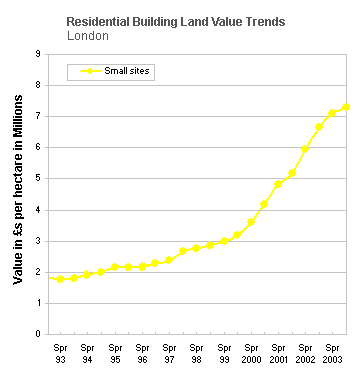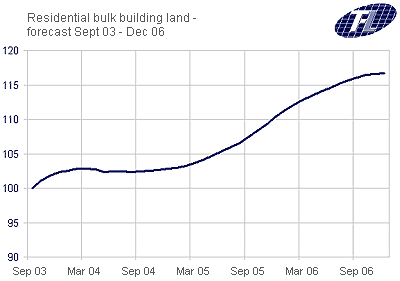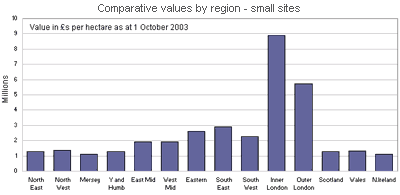Property Market Report Autumn 2003
Land Prices - Historic and Future predictions
Land Prices - Historic
In the Property Market Report - Autumn 2003, the Valuation Office Agency gave the following data of house price rises over the last 10 years.

A small site of typical residential building land in the South East (this does not include Inner or Outer London) that was valued at £588,000 per Hectare in the Spring of 93 was worth £2,760,000 in the Autumn of 2003! By most measures an excellent return on your investment.
The Valuation Office Agency Property Market Report - Autumn 2003 , gives an excellent impartial insight into the latest trends in Land in the UK. I recommend that you click on the links that I have provided and view the report in its entirely.
Note - The Valuation Office Agency (VOA) is an executive agency of the Inland Revenue (IR) with 85 offices spread throughout England, Wales and Scotland employing around 4000 people.
Its main functions are to:
- Value property in England, Wales and Scotland for the purposes of taxes administered by the Inland Revenue
- Provide statutory and non-statutory property valuation services in England, Wales and Scotland
- And give policy advice to Ministers on property valuation matters
Land Prices - Future Predictions
The Property Market Report - Autumn 2003 from the Valuation Office Agency includes a forecast for future Residential Land prices from Technical Forecasts Ltd.
Residential Land Forecast prepared by Technical Forecasts Limited
The residential land forecast

Average values for building land across UK are forecast to stabilise during the period March 2004-05, before a further period of significant growth to end 2006. However, this picture is highly varied in different regions, with bulk building land values in some regions rising considerably more than others. Average year-on-year rates of increase across the country over the next 3 years are forecast as around 5%, although most growth is forecast for the second half of the period.
Uncertainties in the market at a national level include the level of supply of new development sites and the need for more affordable housing units both of which are drivers of land value. A feature of the residential land market is the ‘lumpiness’ of changes in value making forecasting somewhat more hazardous than for markets that respond in a more controlled way to changes in the market place. The forecasts need to be taken together with all other market information that is taken into account in any decision making process.
Background Information
The forecasts have been provided by Technical Forecasts Limited, an established company that is at the forefront in the development of forecasting techniques for the property sector. The techniques adopted for the original series of forecasts published in the Property Market Report have been undergoing continual development. These new systems are based on Bayesian principles and techniques for finding the best average forecasts, given current market forces.
Data Source
The forecasts are based on residential land values which have been collected by the Valuation Office since 1983. The data is based on opinion of value of land in typical locations throughout England assuming the site has a planning permission typical for the location, is ripe for development and has services to the edge of the site.
Methodology
The forecast uses Technical Forecasts' latest methods for forecasting property time series. Radial basis functions have been adopted (a type of neural network) together with information from economic, financial and other property series. The programs select the best economic, financial and property series that give the maximum amount of information to the Residential Land series. Bayesian statistical methods are then used to give the most probable future course of the Land series, given the past data.
The forecasts are made on the basis of relationships that exist in the past history of the data series along with associated economic and financial data. The methods used Construction Orders, Bank of England base rates, Government data series and also Halifax and Nationwide data series as well as other public and private sources of technical data; over 100 other sources of data were scanned and the relevant patterns extracted in order to inform the forecasting process.
Advanced methods of error reduction in the past time series have also been developed . The training of the models is controlled in such a way as to make sure that only the relevant data patterns are used in the creation of the models, eliminating, or at least minimising, any errors that may exist in the data. In this manner only the most relevant past patterns i.e. those that determine the future, are taken into account.
Application
It is important to remember that future values do not necessarily depend on past performance and mathematical techniques cannot take into account sudden social and political changes or other shocks to the market. All forecasts should be treated with caution and should be used in conjunction with professional opinion but they do provide an analysis of relationships within existing data series and present a degree of objectivity over their subjective equivalents.
Technical information about this forecast and on additional property forecasts is available from:
Technical Forecasts Limited
Castle Court
12a High St
Arundel
West Sussex
BN18 9AB
Tel: 0854 2300 456
Email: mandy.bradley@tfl.biz
Web Site: www.tfl.biz
Land Values by Region

October 2003
